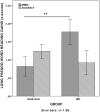The Effectiveness of Interventions for Developmental Dyslexia: Rhythmic Reading Training Compared With Hemisphere-Specific Stimulation and Action Video Games
- PMID: 32581961
- PMCID: PMC7283807
- DOI: 10.3389/fpsyg.2020.01158
The Effectiveness of Interventions for Developmental Dyslexia: Rhythmic Reading Training Compared With Hemisphere-Specific Stimulation and Action Video Games
Abstract
Developmental dyslexia is a very common learning disorder causing an impairment in reading ability. Although the core deficit underlying dyslexia is still under debate, significant agreement is reached in the literature that dyslexia is related to a specific deficit in the phonological representation of speech sounds. Many studies also reported an association between reading skills and music. These findings suggest that interventions aimed at enhancing basic auditory skills of children with DD may impact reading abilities. However, music education alone failed to produce improvements in reading skills comparable to those resulting from traditional intervention methods for DD. Therefore, a computer-assisted intervention method, called Rhythmic Reading Training (RRT), which combines sublexical reading exercises with rhythm processing, was implemented. The purpose of the present study was to compare the effectiveness of RRT and that of an intervention resulting from the combination of two yet validated treatments for dyslexia, namely, Bakker's Visual Hemisphere-Specific Stimulation (VHSS) and the Action Video Game Training (AVG). Both interventions, administered for 13 h over 9 days, significantly improved reading speed and accuracy of a group of Italian students with dyslexia aged 8-14. However, each intervention program produced improvements that were more evident in specific reading parameters: RRT was more effective for improvement of pseudoword reading speed, whereas VHSS + AVG was more effective in increasing general reading accuracy. Such different effects were found to be associated with different cognitive mechanisms, namely, phonological awareness for RRT and rapid automatized naming for VHSS + AVG, thus explaining the specific contribution of each training approach. Clinical Trial registration: ClinicalTrials.gov NCT02791841.
Keywords: action video games; developmental dyslexia; hemisphere-specific stimulation; music; reading; rhythm.
Copyright © 2020 Cancer, Bonacina, Antonietti, Salandi, Molteni and Lorusso.
Figures





Similar articles
-
Music-based and auditory-based interventions for reading difficulties: A literature review.Heliyon. 2022 Apr 18;8(4):e09293. doi: 10.1016/j.heliyon.2022.e09293. eCollection 2022 Apr. Heliyon. 2022. PMID: 35497042 Free PMC article. Review.
-
Improving reading skills in students with dyslexia: the efficacy of a sublexical training with rhythmic background.Front Psychol. 2015 Oct 6;6:1510. doi: 10.3389/fpsyg.2015.01510. eCollection 2015. Front Psychol. 2015. PMID: 26500581 Free PMC article.
-
Action video games improve reading abilities and visual-to-auditory attentional shifting in English-speaking children with dyslexia.Sci Rep. 2017 Jul 19;7(1):5863. doi: 10.1038/s41598-017-05826-8. Sci Rep. 2017. PMID: 28725022 Free PMC article.
-
Improving action video games abilities increases the phonological decoding speed and phonological short-term memory in children with developmental dyslexia.Neuropsychologia. 2019 Jul;130:100-106. doi: 10.1016/j.neuropsychologia.2018.10.023. Epub 2018 Nov 3. Neuropsychologia. 2019. PMID: 30395809
-
How the visual aspects can be crucial in reading acquisition? The intriguing case of crowding and developmental dyslexia.J Vis. 2015 Jan 14;15(1):15.1.8. doi: 10.1167/15.1.8. J Vis. 2015. PMID: 25589292 Review.
Cited by
-
Visual Attentional Training Improves Reading Capabilities in Children with Dyslexia: An Eye Tracker Study During a Reading Task.Brain Sci. 2020 Aug 15;10(8):558. doi: 10.3390/brainsci10080558. Brain Sci. 2020. PMID: 32824168 Free PMC article.
-
Music-based and auditory-based interventions for reading difficulties: A literature review.Heliyon. 2022 Apr 18;8(4):e09293. doi: 10.1016/j.heliyon.2022.e09293. eCollection 2022 Apr. Heliyon. 2022. PMID: 35497042 Free PMC article. Review.
-
Remote Neuropsychological Intervention for Developmental Dyslexia with the Tachidino Platform: No Reduction in Effectiveness for Older Nor for More Severely Impaired Children.Children (Basel). 2022 Jan 5;9(1):71. doi: 10.3390/children9010071. Children (Basel). 2022. PMID: 35053699 Free PMC article.
-
Predicting Response to Neuropsychological Intervention in Developmental Dyslexia: A Retrospective Study.Brain Sci. 2024 Jul 31;14(8):775. doi: 10.3390/brainsci14080775. Brain Sci. 2024. PMID: 39199469 Free PMC article.
-
Prismatic adaptation coupled with cognitive training as novel treatment for developmental dyslexia: a randomized controlled trial.Sci Rep. 2024 Mar 26;14(1):7148. doi: 10.1038/s41598-024-57499-9. Sci Rep. 2024. PMID: 38531968 Free PMC article. Clinical Trial.
References
-
- Bakker D. J., Licht R. (1986). “Learning to read: changing horses in midstream,” in Dyslexia: Neuropsychology and Treatment, eds Pavlidis G. T., Fisher D. F. (London: Wiley; ), 87–95.
-
- Bhide A., Power A., Goswami U. (2013). A rhythmic musical intervention for poor readers: a comparison of efficacy with a letter-based intervention. Mind Brain Educ. 7 113–123. 10.1111/mbe.12016 - DOI
-
- Cancer A., Antonietti A. (2017). Remedial interventions for developmental dyslexia: how neuropsychological evidence can inspire and support a rehabilitation training. Neuropsychol. Trends 4 73–95. 10.7358/neur-2017-022-canc - DOI
Associated data
LinkOut - more resources
Full Text Sources
Medical

